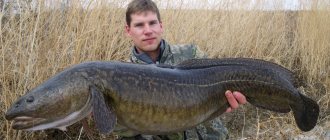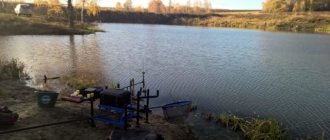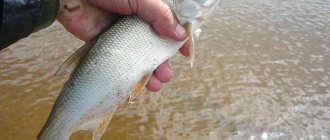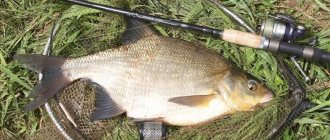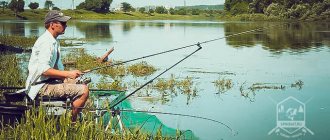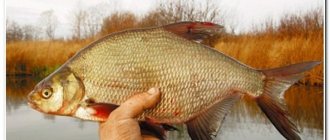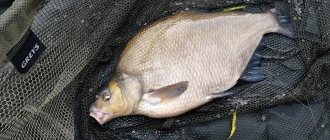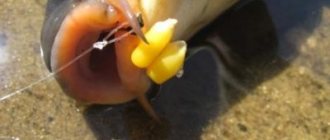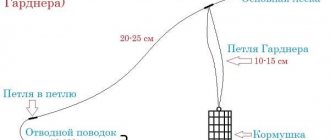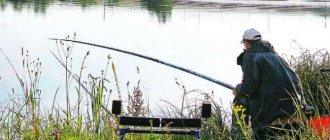Rod selection
The feeder on the river is used of a heavier class than when fishing on a standing reservoir. This choice is due to the fact that there is a current here and the stronger it is, the heavier the feeder we must use so that the current does not carry it away.
Fishing with a feeder on the river is successful with long blanks, while most anglers advise placing the rod so that its tip is raised as high as possible (for which high stands are specially used). This is justified by the fact that in this case, there will be a minimum of fishing line in the water, and the current will not have such a strong effect on the feeder. If the rod is positioned with the end down, then it will affect the entire line in the water and we will have to use larger feeders and coarser tackle.
This is only true when, at the point where the fishing line enters the water, the strength of the current does not differ significantly from the strength of the current near the shore. But if we are fishing on a riverbed, where the current is stronger, then our line should enter the water much earlier, since the maximum speed of the current is just near the surface, but the further into the depth, the weaker it is.
As a result, it turns out that it is better for a larger section of fishing line to be affected by a weak current than a smaller, strong one.
Feeder rods are divided into classes:
- Pickeras are small rods designed for casting light feeders weighing up to 20-25 grams. They range in length from 2.1 to 3 m. A good choice for feeder fishing on rivers and canals with weak currents.
- Medium - designed for using feeders weighing 30-50 grams. They reach a length of 3-3.6 m, sometimes you can find mediums 2.4 -2.7 m and 3.9 m long.
- Heavy ( Heavy ) - quite massive forms, designed for the use of feeders weighing up to 100 grams. They range in length from 3 to 4.5 m.
- Extra Heavy - powerful feeder rods with weight from 120 grams. Such rods are designed for fishing at the longest distances in strong current conditions. When using them, it is worth remembering that the further we cast, the more difficult it is to hit one point and create a normal feeding spot.
Mainly on a stagnant body of water, rods of the light and medium classes are used; on the river, feeders of the medium and heavy classes are more relevant, since feeders weighing 50, 70 and 90 grams are used here, and in strong currents Extra Heavy
Which feeder should a beginner fisherman choose?
Vyacheslav Redkin aka tanai will help us understand this fundamental issue and give practical advice . He began to get involved in feeder fishing professionally 5 years ago, and already in 2021, when bottom fishing competitions began to be held in Novosibirsk, he decided to try his hand at the sport. In the same year, he became the champion of the Novosibirsk region as part of the team, and then took 2nd place at the championship of the Kemerovo region. I missed 2021 due to being busy, and in 2021 at the City Championship I continued to take prizes - 3rd team place as part of the “I Know Fishing” team.
Quote: “Which feeder to choose? Before you go to the store, you need to know what you want, since in 90% of stores, when asked to sell a feeder, you will be offered a so-called “crocodile”. In order to decide what you want, you need to answer several questions.
- The first and perhaps most important is your budget. One good thing is that now there are a lot of decent fishing rods for reasonable money.
- The second is the body of water where you are going to fish.
If you want to fish on the country pond on weekends and go to the Ob River on weekdays in the evenings, then I will disappoint you, there are no universal rods .

And so, we’ve decided on a budget and a reservoir, and we begin to choose. If you prefer small ponds, rivers with a very slow flow, where the fishing distance will be up to 30 meters, you should purchase a so-called picker rod with a height of 3 - 3.3 meters and with a test weight of 25-50 grams. If the distance increases to 50+ meters, then you will need a rod with a height of 3.6 m. The test can be selected up to 70 g if you are fishing in a reservoir without a current. If this is a reservoir with moderate heat, then you should choose a more powerful rod - up to 90-110 g. With such a rod you can already catch carp on the platform, go to Ugryumka, and even go fishing here and there on the Ob. Next comes heavy and extra heavy. These are rods with heights of 3.9, 4.2, and 4.5 meters. I have never caught 4.5 m and have not yet understood whether I need it, but 3.9 and 4.2 - yes, I do. Especially for those who prefer fast-flowing rivers and need a long cast. Using a 4.2 m rod with the correct size 6000 reel, with the proper skill you can “place” the feeder at a point at a distance of up to 100 meters. And with a rod with a dough of 140-180 g, you can throw heavy feeders of 100, 120 g plus food, and they will calmly lie on the bottom of a river like the Ob. For a 3.9 rod, the comfortable distance is 70-80 meters.
A comfortable distance is the distance to which, with some skill, you can easily send the feeder while sitting on a chair. It’s unlikely that you’ll be able to throw it so successfully the first time; everything will come with training and experience.
- Seminar No. 1 is devoted to feeder rods and reels, their classification and selection.
I said that there are no universal rods, but perhaps a rod with a height of 3.6 and a weight of about 120 grams can be called such. But how universal is it? It will not be very comfortable to fish with such a rod at short distances due to frequent recasts and the weight of the rod - all the excitement from fishing will quickly be replaced by fatigue. You will also have to fully invest in long-distance casting. First of all, we go fishing for pleasure, and I would recommend choosing a fishing rod so as not to puff up, but to catch fish comfortably.
Another very important criterion when choosing a fishing rod for a novice fisherman is the availability of spare parts for sale. I know many people who have been fishing with feeders for a long time and still break their quivertips from time to time. They break in 99% of cases only because of a fisherman’s mistake. And, of course, a beginner is not immune from these mistakes. In the city, of course, the number of stores selling correct feeder rods is growing, but spare parts can also be bought through online stores, sometimes even cheaper than here. Keep this in mind when choosing your first feeder rod.”
- Seminar No. 1 is devoted to feeder rods and reels, their classification and selection.
Reel for fishing with a feeder on the river
Power, with a gear ratio of 4.7:1-5.2:1, a faster one should be taken only for catching small fish. Spool 2500-3500 for small specimens and 3500-4000 or more for large ones. The number of bearings 4 is better than 6, plus one in the line roller. You should not go for 15 bearings from cheap Chinese manufacturers; you will only be disappointed, since quantity here will significantly lose out on quality. In cases of fishing with braided line, the spool and line roller must be coated with titanium nitride or made of durable material.
Fishing with a feeder on the river equipment
A feeder on a river also sets its own requirements for feeders; they should not slide along the bottom under the influence of the current, so triangular and rectangular feeders are mainly used. If you put a cylindrical one, then it should be metal with a flat base.
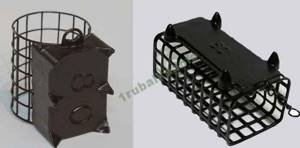
In general, for fishing in the current it is better to use a feeder with lugs.
Types of installation used for river fishing with feeder
For flow, the following methods of installing feeder equipment :
- Gardner's loop or paternoster
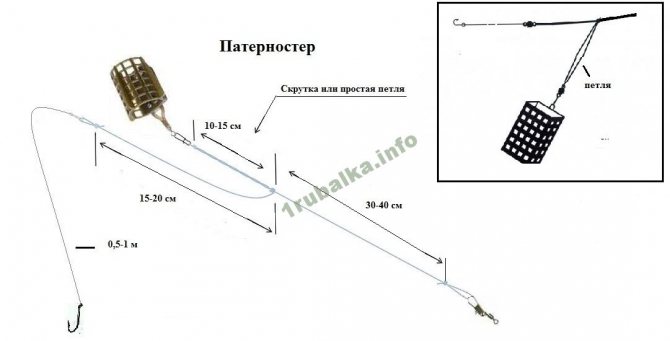
- Symmetrical or asymmetrical loop

- Helicopter and two knots
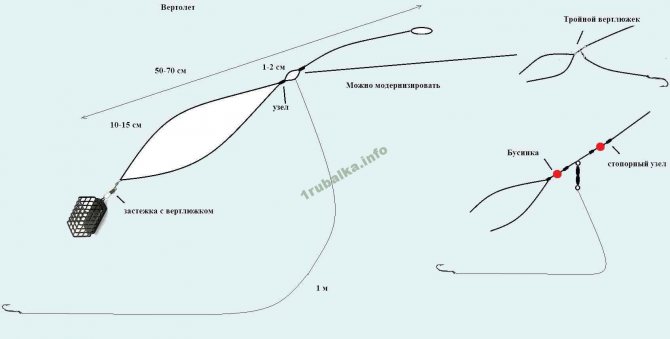
- Anti-twist tube
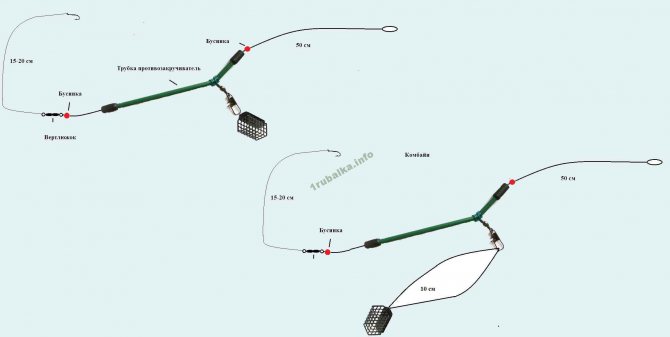
The paternoster has the greatest sensitivity of an asymmetrical and asymmetrical loop. When choosing equipment, you need to look at how it will behave in a given body of water. If it doesn’t get confused, overlaps are very rare and at the same time the sensitivity makes it possible to respond to bites in a timely manner, then this equipment is worth catching and nothing special don't split hairs. If fishing with a feeder on the river occurs with constant overlaps, then you need to change the equipment in order to achieve a minimum amount of overlaps and twisting. Also a signal that our equipment is not working well is a hook that is heavily swallowed by the fish. In this case, we have poor sensitivity and react late to the bite. Perhaps it is worth reducing the length of the leash, and then we will immediately see the bite and react in a timely manner. With a normally adjusted tackle, the hook should catch the fish by the lip.
When using a feeder on a river, there are times when it is better to remove the feeder and use a regular sinker instead (the best option is a spoon weight). This should be done when you have well-fed the place, and there is no need for constant supplementary feeding or there is a possibility of overfeeding the fish, then a temporary replacement with a sinker will help improve the bite, since the noise from the sinker hitting the water is less than from the feeder.
fishing with a feeder on the river, selecting a feeder by weight
We take an empty feeder and throw it in, if it lies dead on the bottom, then the feeder is very heavy, and we will lose sensitivity; if the current carries it with us, then it is light and we will not be able to fish with it in a well-fed place. A properly selected feeder should barely stay in the current. When selecting the weight of the feeder, we do not take into account the weight of the bait, since it will be washed out and, accordingly, our feeder will begin to be carried away from the feeding place
fishing line
If fishing with a feeder on a river is carried out at a distance from the shore of more than 30 m, we need to use braided fishing line as it provides excellent signals of a bite. If the current is strong or you need to cast 60 meters, it is better to use an 8-core braided line because it is more streamlined than a 4-core line, and accordingly it has less windage in the current and wind, but a 4-core line has greater wear resistance and is recommended when fishing on rocky and shell-covered day. When fishing at short distances up to 30 m, especially for large fish, use a monofilament line.

Habits
When fishing with a feeder on the river, baits 60 cm long are mainly used, but their length depends on the bite. If the fish takes it carefully, then the length of the bait should be increased; if the bite is active, then decrease the sensitivity of your tackle and the sensitivity of your tackle will increase. The bait should be set 0.02 mm thinner than the main line or 10-15% weaker if we are fishing with braid.
When we have braided line, there is no point in cutting sharply; during the bite, you need to take the rod and gently and quickly lift it up. With such a hook, we avoid a sharp blow (since braid, unlike a monk, does not stretch) and reduce the likelihood of the fish tearing its lip.
Hooks
Used with increased strength. The worse the bite, the smaller the hook you need to use. The most popular feeder hook is No. 10-12 according to the international classification; such hooks are suitable for both relatively small and large fish.
Friction Brake Setting
First of all, we must correctly configure the friction brake, and the adjustment is made taking into account the friction of the fishing line on the rings. Ideally, you need an assistant who will hold the edge of the fishing line in his hand, and at this time, lifting the rod up and creating tension, we will set the friction (in extreme cases, you can tie the edge of the fishing line to something).
Feeders and leashes
Due to the fact that the fishing distance on a small river is short and the bright aroma of bait attracts fish from all horizons, when installing equipment it is recommended to use mesh feeders made of metal or plastic with medium and small feed capacity.
Depending on the strength of the current, the weight of the feeder is chosen; it is necessary that it be held at the bottom, but the fish could tear it out of place when biting.
When using bait with animal components, choose closed-type feeders that can hold the food longer and thus attract fish.
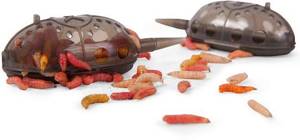
On a small river, the shape of the feeder is not of fundamental importance; what is more important is how quickly it releases food into the water.
The leashes are knitted from monofilament fishing line with a diameter of 0.08–0.12, as well as fluorocarbon 0.10–0.14 mm, which has excellent camouflage characteristics.
Rigs for picker fishing are knitted on the main line, and popular among them are the helicopter feeder rig and two knots, which is convenient in both strong and weak currents.
Small fish require sensitive gear and therefore the use of:
- paternosters;
- asymmetrical loop;
- inline;
- symmetrical loop.
Each angler has his own preferences for choosing a fishing rig, especially since his choice also depends on the conditions in which fishing is carried out.
Choosing a place for feeder fishing on the river
When choosing a fishing spot, you need to make sure that there are no overhanging branches above your head that will interfere with casting. You also need to pay attention to the area behind you, because when casting, a long lead can easily catch a snag or a stem of grass. It is also advisable that there are no snags or a thick carpet of algae in the water in front of you, which could interfere with landing the trophy.
Fishing with a feeder on the river is successful in areas where there are various eddies and reverse currents, they indicate that the bottom in this place is heterogeneous and there are edges and drops that fish love so much.
Basically, having come to an unknown body of water, the fisherman looks for the edge and fishes in its lower section. What an edge is, in simple terms, is a steep descent to depth and adjacent areas; in front of the drop, as a rule, there is a flat terrace, table or irrigation. The area where the terrace (table, watering) turns into a dump is called the “upper edge”. Gradually, the descent on the edge becomes gentler and smoother, or even almost even - this is the “lower edge”, this is the area that the angler needs to look for and fish on it. If the river is wide, then the lower edge can turn into another dump to a greater depth. It is not recommended to fish on a dump, otherwise all your bait will roll down, and in cases of fishing on rocky dumps, you will definitely leave more than one feeder on it. In spring and at night, fish can go out to the shallows and stay near the upper edge.
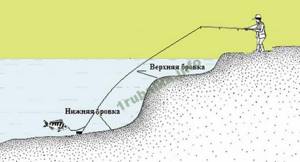
When choosing a fishing spot, you should navigate not only by the bottom topography, but also pay attention to the river bank. So, behind the shore ledges and capes, a return flow forms if the current is strong or calm water if it is small. In such places, holes often appear and food carried by the current accumulates. In addition, the fish does not need to make excessive efforts to fight the current.
A feeder on a river can be effective when fishing in places where the river borders a tributary or an oxbow lake, and depending on the speed of the current, one bank may have shallow water, while the other may have channel pits in which food accumulates.
Promising areas are the entrance and exit from the riffle, especially if there is a hole at the exit of the riffle. The riffle itself is not suitable for feeder fishing, since the current here is very intense and there is a high probability of getting caught, as a result it is very difficult to create a normal feeding spot.
In spring, during high water, you need to look for shallows and pumps; here the water warms up faster and the fish bite quite actively.
Ideally, first study the river using an echo sounder. The disadvantage of this method is that you will need a boat and an echo sounder itself. True, the result will please you not only with knowledge of the bottom topography, but will also give you the opportunity to see whether there are fish here at all and in what quantity. As you know, it is much easier to keep the fish at the fishing point than to lure it to you with a large amount of bait.
But for most fishermen, a feeder on a river does not involve the use of an echo sounder. Take an ordinary weight and braided fishing line, throw in the tackle and begin a leisurely reeling, so that the weight drags along the bottom. If the load hangs or falls through, it means there is a hole or changes in the bottom; if we feel resistance while fishing, then we have found a rise. Areas where there are differences in the bottom and the lower edge is located are quite promising and we need to mark the distance to which we will cast our tackle; for this, the fishing line is clamped into a clip or a mark is made with a marker. At the same time, a landmark is selected on the opposite bank, in the direction of which we will cast. It is better to control the casting distance with a marker than with a clip, because in case of a strong bite, the clutch will work and the line will begin to reel in, it will quickly reach the place where it is clamped by the clip and will break. Therefore, it is better to use a clip when catching small fish, but for bream, carp or chub, make marks on the fishing line with a marker. In addition to the bottom topography, we also determine its type: on hard ground the load moves easily and evenly, if the bottom is muddy, then the wiring runs with little tension. On a rocky and shell-covered bottom, the weight moves with a noticeable tremor. You can also measure the bottom topography using a marker float.
Stages of feeder fishing
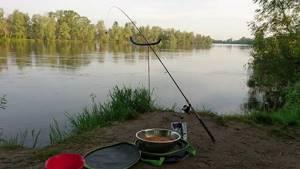
Operating a feeder is somewhat more difficult than a traditional fly rod float rod, but this tackle is traditionally considered more productive and suitable for hunting large specimens. The main thing is not to neglect any stage both in preparation for fishing and during the process itself. It is also important to take into account the weather conditions: in case of strong gusty winds, sudden cold snap or on the eve of a thunderstorm, it is better to postpone leaving.
The following stages of feeder fishing can be distinguished:
- arrival at a reservoir, search and identification of a catchable place;
- study of bottom relief;
- starting feeding of the fishing square;
- casting the tackle (the most difficult stage to perform);
- response to bite and hooking;
- catching fish.
Each of these stages is characterized by certain features and therefore requires closer consideration. So, we imagine that we have already prepared for fishing, asked feeder fans about nearby reservoirs, did not forget to take bait and bait with us, and arrived at the location.
Finding and preparing a site
To cast a feeder, free space is required, so when choosing a fishing spot, especially at first, focus on areas of the coast without bushes and trees. It is advisable to clear the coastal area of sedge and other vegetation: it will inevitably create problems when fishing.
If you are looking for a promising place on a reservoir with standing water, you should focus on places with a gradual rise in bottom relief (that is, it is better to fish not at depth, but on the slope of the depression - more food is brought there). Sometimes areas with a flat bottom are also good, especially if they are located on the borders of aquatic vegetation that does not interfere with casting and fishing. If we talk about fishing on the river, it is advisable to visually identify water areas with a slower flow or fish in large backwaters, deeply cut into the shore.
To determine the depth of the fishing spot, as well as the nature of the bottom surface, use a weight attached to the main cord. The reference weight is 40 grams: in stagnant water, such a load sinks to the bottom at a speed of a meter per second. Several casts and simple calculations are made - and the bottom topography appears in front of the angler.
It is also advisable to examine the nature of the surface: a bottom that is too muddy or clogged is of little use for bottom fishing. You can use the same weight that needs to be dragged along the bottom, monitoring the behavior of the quivertype and your own feelings. If the load moves evenly without jerking, then we are dealing with an even or smooth terrain and a bottom of sufficient hardness, suitable for feeder fishing. It’s not bad if there is a slight shaking: this is an indicator of the presence of small pebbles or shell rocks, where a lot of “delicacies” accumulate, which means that the fish are used to eating in this square.
After determining the fishing area, the cord should be clipped or secured with a rubber band directly on the spool. At long distances, a tolerance of 1-2 meters is given for line sagging. It is necessary to detect not only the distance, but also the direction. This goal is achieved either by choosing a landmark on the opposite bank, or by installing a pair of stakes in the desired direction.
We remind you: purchasing and using an echo sounder will greatly facilitate the search for a promising square and even indicate the location of the fish.
Feeding

After identifying a promising location, you should begin preparing the feeder and preparing the bait mixture. If you are using a ready-made mixture, you just need to knead it according to the instructions. In other cases, it is advisable to take with you fish feed and large fractions prepared at home (barley, peas, steamed cereals, and so on).
Productive fishing with a feeder is unthinkable without creating a “bait spot” in the casting area. Primary feeding at short distances is carried out by hand, from a slingshot or other devices (cobras, catapults) with large balls or boilies with negative buoyancy.
At considerable distances, rocket feeders, which have already been mentioned above, perform best. In usual practice, 5-10 casts are made, but during the current it is rational to feed the fish “richer”. Special radio-controlled boats and catamarans provide maximum accuracy in delivering a large amount of mixture with a relative noiselessness of the process.
Experienced fishermen (mainly carp anglers) practice baiting fish several days before fishing, periodically feeding a bait mixture to the fishing point or installing stakes in the water with “bags” filled with gradually dissolving bait.
Casting
The most difficult thing in feeder fishing is learning to throw the tackle into a certain square, ideally with an accuracy of half a meter, without going beyond the formed bait spot. Before casting, be sure to make sure that the cord does not wrap around the tip of the quiver tip, otherwise it may fly into distant distances along with the feeder.
For beginners in feeder fishing, we can recommend using the simplest method from behind : if there are no bushes or trees nearby, and the swing is carried out with sufficient force and in the right direction, everything will definitely work out. To increase the range, you can use special feeders, as well as running casting, and 3-4 steps are enough. There are other methods (for example, “English” or “pendulum”), but they are quite difficult to perform and are recommended for mastering after perfecting casts from behind the back.
After a successful cast, you should carefully place the rod on the stand in the direction of the cord and, if necessary, use the reel to pick up any slack in the line. Now that’s it: you can calmly observe the behavior of the quivertype. If it gradually deviates to the side, it means that you should pick up a heavier bait (it is carried away by the current) and repeat the cast.
Bite and hook
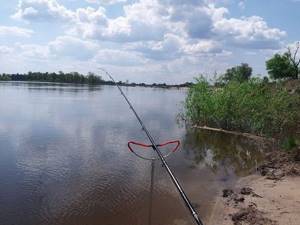
Each fish has its own biting style, which is reflected in the “behavior” of the tip of the blank. For example, a small vibration indicates that small fry are interested in the bait and are actively “sucking” it. As a rule, after such “slotting” there is a lull. This means that the small fish has already managed to use the bait and expose the hook, that is, the tackle needs to be reloaded and cast again.
A large individual can also try on the bait first, but more often it grabs the bait right away. This is expressed in a sharp bend of the quivertype, and in some cases, a jerk of the entire form. A solid specimen can even drag the rod out of the fisherman’s hands, therefore, when fishing for trophy fish on a feeder, it is advisable to use a reel with a baitrunner, which ensures instant line return.
However, unlike a float rod, this tackle gives enough time to react to a bite: it should not be so fast as it should be correct. After the bite, you should carefully lift and pull the rod towards you, avoiding excessively sudden movements, otherwise you can either break the equipment or tear the fish’s lip and “safely” let it go.
Fishing
The most enjoyable stage is landing the treasured prey. It should be started immediately after hooking, feeling the resistance of the cord with the quiver tip bent. Small fish offer modest resistance, so they can be directed straight to the shore by gradually winding the line onto the reel.
Respectable specimens are desperately fighting for life, so when fishing them you need to follow certain rules. This technique is called "pumping." It involves periodically raising the rod to an angle of about 80 degrees, alternating with lowering the blank while simultaneously reeling in the fishing line. A properly configured clutch plays an important role here. When the desired prey has almost reached the shore, you should lift the form and give the fish a breath of air, ideally lay it on its side.
In the end, it is wise to use a landing net: lifting a large fish above the water on a fishing line is not recommended: this is fraught with the risk of it disappearing at the most crucial moment. Fishing with a feeder is good because a large specimen can be hooked even by a green beginner in poor biting conditions, so a landing net should be in your arsenal from your first fishing trip.
The feeder is an amazing piece of equipment that demonstrates enviable performance when handled correctly. We hope that this article will help you become inspired to master this type of fishing!
Fishermen wonder why I’m biting and they’re not?
I’m revealing a secret just for you: it’s all about the miracle bait! More details
Feeder on the river casting features
The feeder cast is made from behind the head, not the shoulder, since casting over the shoulder does not provide the required accuracy. Starting position: the left hand with the butt of the blank is directed towards the casting point, and the right hand is located above the top of the head. During the flight of the tackle, we continue to hold the rod raised up and when the line reaches the clip, or marked area, we feed the blank forward and lower it parallel to the ground.
If you throw the feeder downstream, at an angle of 45 degrees or less, then fishing with a feeder on the river will be possible right next to the shore, the advantage of such fishing is that you are at a distance from the fish, and it does not see or hear you.
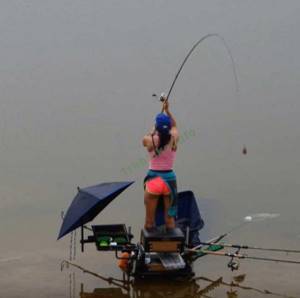
It happens that you pick up a feeder, and it flies perfectly, there are no overlaps, you react to bites in a timely manner, but you have a desire to try to throw a little further, where the current is stronger. Of course, you can install a heavier and larger feeder. But the problem is that the larger the feeder, the more windage it has and there is a possibility that it will not stay with the current, but will be carried away. In this case, we need to add additional weight to our feeder by placing a 10-20 gram ear through the winding ring; in this case, the weight of the feeder will increase, but the windage will not. The sinker must be secured inside the feeder, then it will not get caught on it and the tackle will not get tangled.
Lure
Feeder fishing on the river involves the use of viscous bait, which will not crumble when it hits the water. You can buy bait specially designed for these purposes or a regular float bait, and add clay, ground oats or flour to it.
The proportions can be selected right on the pond, taking a little bait and adhesive components, mixing and throwing them near the shore to see how the bait behaves, is washed out of the feeder or lies as a dead weight. The viscosity of the bait should be such that the bait is washed out in 3-5 minutes. Read more about choosing feeder bait here .
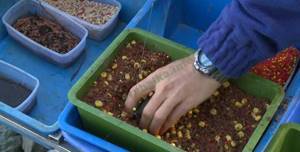
It's good when your bait includes bait. If these are animal components, then you should not throw them at the time of mixing the bait. During the fishing process, we take a feeder, hammer some of the bait into it, then add a little maggot or chopped worm, then put the bait in again. The speed at which the bait is washed out can be adjusted by the degree of moistening of the bait; over-moistened bait is washed out more slowly.
Feed preparation
The next important point when fishing on a river with a feeder in fast water is to prepare bait and serve it correctly. You can choose any bait. You can buy it at the store, or cook it yourself.
The base can be varied - crackers ground into fine crumbs, semolina, boiled potatoes. It all depends on the fish that you will be fishing for. Flavorings or attractants are also needed. But regarding the use of attractants (chemical nutrients that act on living organisms), fishermen argue a lot and have not yet come to a clear conclusion about how they act. Some claim that, on the contrary, they repel certain types of fish. But, nevertheless, the white fish that we catch on the feeder really loves different smells and needs to be provided with them.
It is better to prepare complementary foods on the shore, since in a boat, especially in a strong current, it will be inconvenient to do this and the boat can get dirty. Dry components of complementary foods must be mixed with water from the reservoir where you will fish. You need to be more careful with the liquid component, water, because if you pour a lot of it, then the dry mixture may not be enough, and complementary foods should be viscous, not liquid. Water must be added little by little.
Since the time interval between throwing the complementary food is 5-7 minutes, the time it takes for it to disintegrate when falling out of the feeder should be the same. This factor determines the viscosity. Here clay can be added as a binding element.
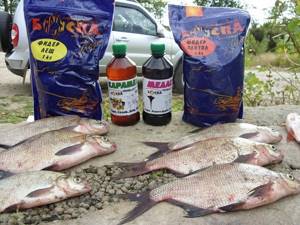
This complementary food can be purchased at the store
Fishing from the shore is configured to form a cloud of turbidity from the feeder when it comes into contact with the bottom. But in strong currents this method will be ineffective.
In the video you can see how feeder feeders behave in strong currents.
Fishing with a feeder on the river from a boat
The advantage of this type of fishing is that we can get to hard-to-reach areas, accurately place the tackle in the stream or fish along the edge. Fishing with a feeder on the river from a boat is carried out with a picker, and you can put feeders on them that weigh more than the test rod. In this case, you shouldn’t expect overload, since you won’t be casting far, and the casting method is pendulum. The weight of the feeder should be such that it stops as soon as it touches the bottom.
If bites are very rare when fishing from a boat, it is easier to change the place of fishing than to intensively feed the point and wait for the fish to come up. When fishing from a boat with a pickerel, it is worth using a monk, since the distance is short and the monk will dampen the jerks of the fish.
In cases of fishing in a weak current, one anchor will be enough for us; we need to drop the anchor from the bow. In this case, the boat will stand with its bow against the current and cut it, reducing the effect of the current on the boat.
If the current is medium or strong, then you need to place the boat on several anchors, stretching it. To do this, we throw one anchor, then wait for our boat to be carried away by the current or, helping ourselves with oars to speed up this moment, we move down and set another. After choosing an anchor rope, we rise a little upstream, so that the rope holding the anchor, thrown downstream, is taut. As a result, our boat is rigidly fixed.
Fishing in the current
Fishing with a feeder in a strong current requires a more powerful rod, a heavier feeder and special techniques for fishing in the current of the river. The main method of catching, for example, trophy bream is pumping.
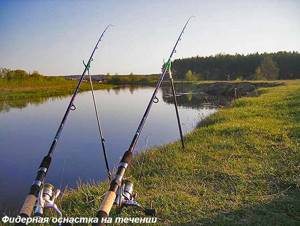
This is especially true when using braided fishing line as the main one. It is unacceptable to try to use a reel to immediately pull out a resisting large fish. A bream released at a distance to the surface can easily fall off the hook. Having gulped for air, such a fish begins to struggle intensely in panic, and interfere with a calm pull to the shore.
To prevent this, the reel clutch is loosened and the fish is carefully pulled in with the rod holding the reel spool with your finger. At the end of the pull-up, the fishing line is selected with a reel, with the rod gradually lowered towards the water. This repeats several cycles until the prey is removed from the water.
